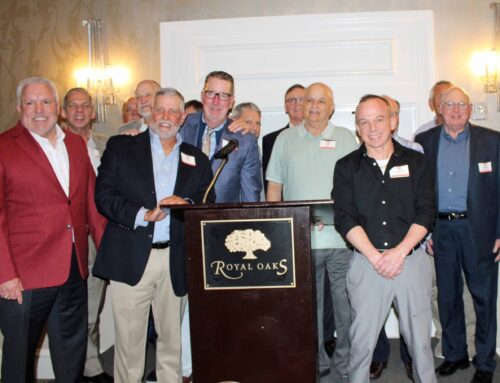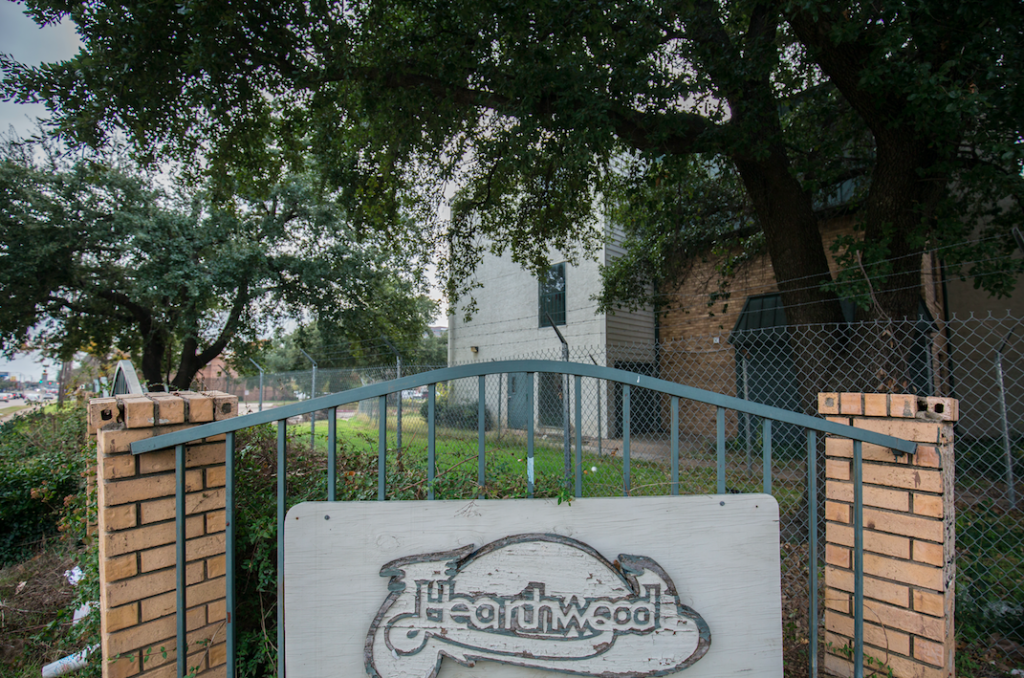
The Hearthwood Condominiums, which burned for the last time in 2013, are slated for redevelopment. (Photo by Rasy Ran)
Three years ago, a blaze left one firefighter dead and a vast swath of earth in ruins. The company that bought the foreclosed-upon property now hopes to construct a contemporary, high-rise building that will attract “young professional families.”
An inferno at the aging Hearthwood North Condominiums in 2013 caused the death of Lake Highlands native Stan Wilson and left behind more than grieving family and friends and embattled investigations.
Since the fire, some nine acres of debris and potential peril has plagued the property, which, even before that final fatal flame, reportedly had seen its share of trouble — “The condo’s homeowners association was in bankruptcy. Board members feuded bitterly. The complex grappled with several lawsuits, declining property values and two previous fires,” according to a 2013 Dallas Morning News story.
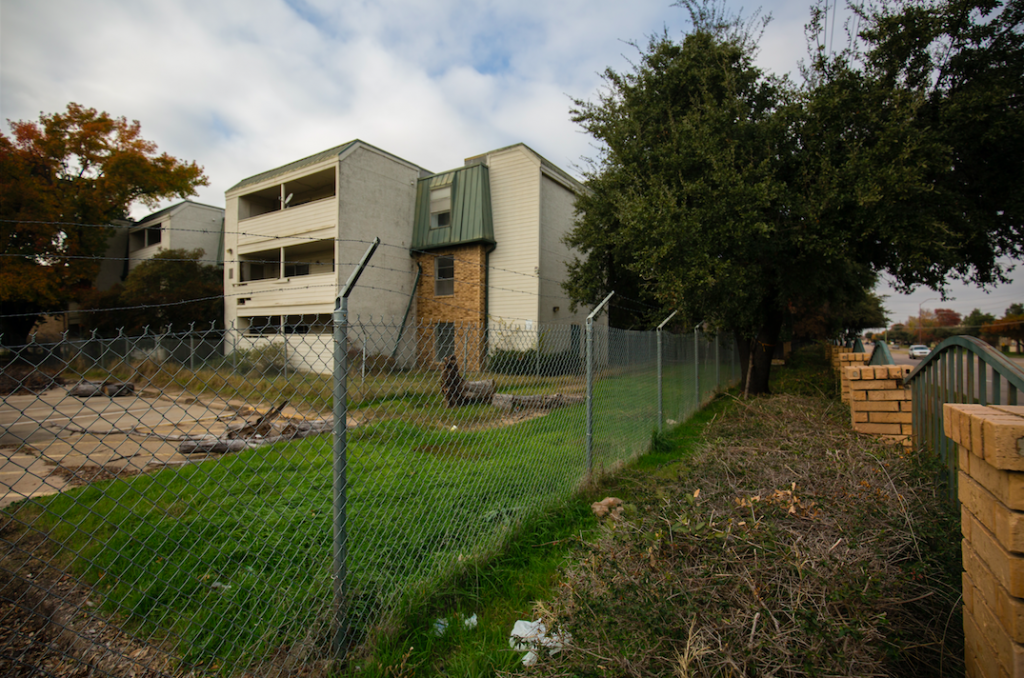
The Abrams Road property dubbed “Chernobyl” by some neighbors, while an eyesore, is not hazardously toxic based on recent inspections. (Photo by Rasy Ran)
It plagued the residents of the abutting Chimney Hill neighborhood, who had taken to calling the remains “Chernobyl,” which I heard at a homeowners association meeting a few months ago, so dubbed for the infamous Ukrainian nuclear plant disaster that posed toxic threats to nearby areas long after the initial explosion.
Despite the nickname, spokesperson Linda Ghaffari with Affinity Strategic Partners on behalf of the property’s new owners GVN Construction told a roomful of Chimney Hill homeowners that the site has passed inspection by both an independent company approved by the State of Texas as well as the Department of Health and Human Resources.
At the insistence of one attendee, she promised to publicize the results of said inspection on a website she is creating for GVN’s proposed new project, whose working name is Dallas Grand Plaza.
This means the property is primed for phase one of redevelopment, which includes cleanup and demolition of existing structures.
She acknowledged neighborhood concerns about squatters living in the charred-out apartments and says that by April 2017, there will be nowhere for them to stay. “The land will be flat as a pancake,” she says.
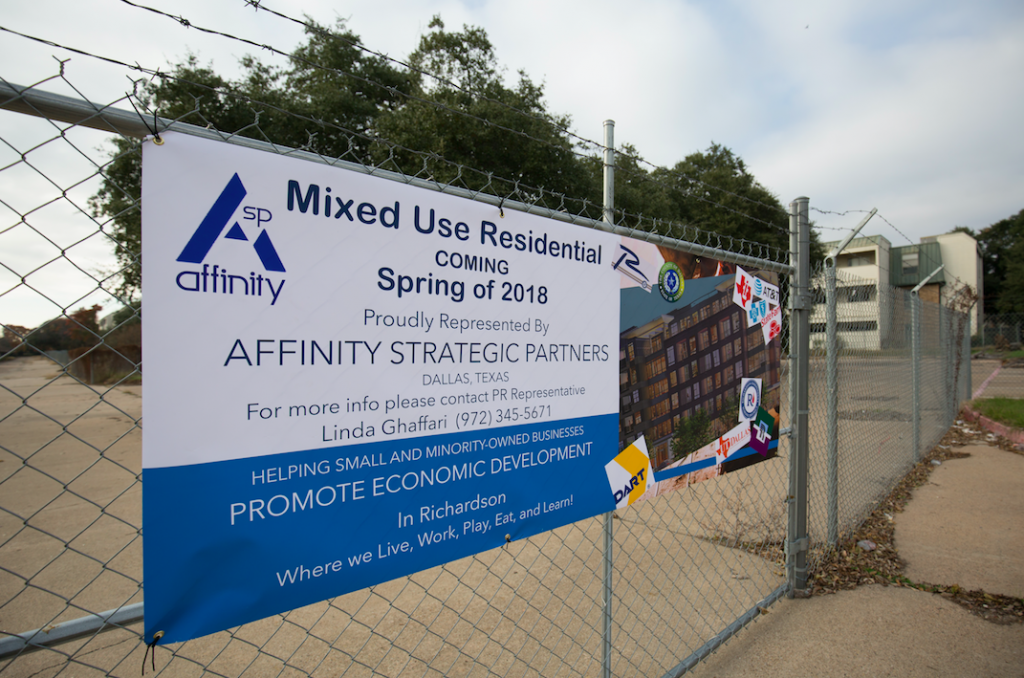
Publicist Linda Ghaffari of Affinity Strategic Partners spoke Monday to a group of homeowners about a proposed new high-rise development. A new fence and signage was step one in an ambitious reconstruction plan. (Photo by Rasy Ran)
Much of what follows will depend on planning and zoning and Dallas City Council rulings, she explains to neighbors before launching in to a slideshow that features several potential designs, including one that reveals a six-story, plus two levels of parking, residential building — that’s 750 units and 900 parking spaces for that particular concept.
The three-story Hearthwood community was home to 240 units before the fire.
Some homeowners express concern about the increased density and traffic; still more murmur agreements with an attendee who says, “I find it very exciting.”
Another notes that a tall building will help block noise from busy I-635, while others worry about a structure towering over their homes and possible overflow parking — “Is 900 spaces enough for 700-750 units?” To which Ghaffari replies, “maybe not” and that this is the sort of thing “discussed during zoning meetings.”
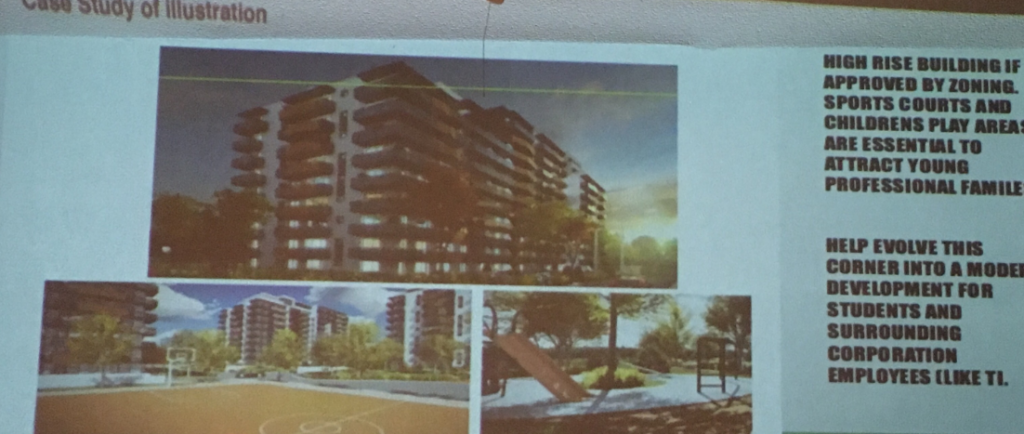
Slideshow from a Monday night meeting depicting an architectural rendering of what developers want to build on the nine-acre property.
The future undoubtedly holds continued discussion regarding the scope of the development. However surrounding stakeholders who attended the presentation applaud the preliminary stage of redevelopment — the fencing-in and securing of land, cleaning of debris and scorched earth, and the demolition of condos, tennis courts and other facilities.
“They will start at the front (Abrams side), getting rid of that eyesore as quickly as possible from the most visible parts and all the way back … it is a very long stretch of land,” Ghaffari says.
We can expect to see more fine-tuned plans and specific zoning change requests by April 30, 2017, she says.
When a re-zoning request is filed, signs with city phone numbers and identification numbers must be displayed on the property in question, thus residents will have an opportunity to accept or argue final submissions before they go to city council for approval. The site currently is zoned multifamily residential.
District 10 Councilman Adam McGough attended the presentation, which was organized by community prosecutor (city code enforcement) Kristen Kramer. McGough didn’t speak much on the topic; he seemed to be on hand essentially to hear neighborhood concerns and input, which will weigh into future plans and decisions. (Though, he was bombarded post meeting with questions about street improvements, which he graciously hung around to answer, which is another story for the not-distant future.)
The project in its entirety is expected to be completed by summer 2018. The faraway completion date is due to the formidable nature of the project, which aims to be “more than a location, a lifestyle, a real community,” according to last night’s presentation.
“Owing to advantageous position and numerous facilities, the idea of home takes on new meanings … thanks to the increased openness to important locations in the city.”
A proposed sports complex, event plaza and extensive green space all are part of the vision, whose overall preliminary proposed footprint is approximately 137,000 square feet, with about 654,000 square feet devoted to residential; about 170,000 square feet to commercial and retail; and some 23,600 square feet to parks, playgrounds, roads and outdoor parking.
Much emphasis reasonably will be placed on the proposed development’s proximity and accessibility to I-635 and Central Expressway, as well as its overall impact on and role within a changing neighborhood.
GBN is interested in purchasing adjoining properties in the area, including apartment buildings and businesses along the I-635 access road.
“There are improvements happening at Skillman and I-635,” Ghaffari points out, “and we want to be a part of that.”
The Skillman corridor, one exit east of the Abrams and I-635 area, is part of a Tax Increment Financing District (TIF) and is slated for an overhaul.
Another upscale development, a modern subdivision of single-family homes, is planned for a stretch of property in-between Skillman and Abrams, just south of Richland College.
We also are looking into the recent purchase of an apartment complex just west of the Hearthwood property; we will soon learn more about what will become of said property.
The proposed new Dallas Grand Plaza development does not fall into a TIF or Public Improvement District, but the developers say they plan to seek tax incentives in order to further “develop more needed improvements in the Abrams/I-635 area,” according to the presentation.





